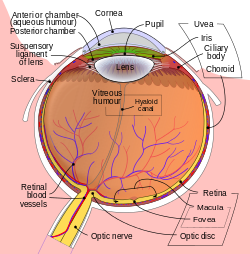

The Ear
The ear is the organ of hearing and, in
mammals, balance. In mammals, the ear is
j
usually described as having three main parts which are—the
outer ear , middle ear and the inner ear . The
outer ear consists of the pinnae and the ear
canal . Since the outer ear is the only visible
portion of the ear in most animals, the term
“ear” often refers to the outer part alone. +
The middle ear includes the tympanic cavity and
the three ossicles . The inner ear sits in the bony
labyrinth ,
and contains structures which are key
to several senses: the semicircular canals ,
which enable balance and eye tracking when
moving; the utricle and saccule, which enable
balance when stationary; and the cochlea, which
enables hearing.
The ears of vertebrates are
placed symmetrically on either side of
the head, an arrangement that aids sound
localisation .
The ear develops from the first pharyngeal
pouch and six small swellings that develop in the
early embryo called otic placodes , which are
derived from ectoderm.
The ear may be affected by disease, including
infection and traumatic damage. Diseases of the
ear may lead to hearing loss, tinnitus and
balance disorders such as vertigo , although
many of these conditions may also be affected
by damage to the brain or neural pathways
leading from the ear.
The ear has been adorned by earrings and other
jewellery in the copious cultures for thousands of
years, and has been subjected to surgical and
cosmetic alterations.
The Eye The Ear
The ear is the organ of hearing and, in
mammals, balance. In mammals, the ear is
usually described as having three main parts which are—the
outer ear , middle ear and the inner ear . The
outer ear consists of the pinnae and the ear
canal . Since the outer ear is the only visible
portion of the ear in most animals, the term
“ear” often refers to the outer part alone. +
The middle ear includes the tympanic cavity and
the three ossicles . The inner ear sits in the bony
labyrinth ,
and contains structures which are key
to several senses: the semicircular canals ,
which enable balance and eye tracking when
moving; the utricle and saccule, which enable
balance when stationary; and the cochlea, which
enables hearing.
The ears of vertebrates are
placed symmetrically on either side of
the head, an arrangement that aids sound
localisation .
The ear develops from the first pharyngeal
pouch and six small swellings that develop in the
early embryo called otic placodes , which are
derived from ectoderm.
The ear may be affected by disease, including
infection and traumatic damage. Diseases of the
ear may lead to hearing loss, tinnitus and
balance disorders such as vertigo , although
many of these conditions may also be affected
by damage to the brain or neural pathways
leading from the ear.
The ear has been adorned by earrings and other
jewellery in the copious cultures for thousands of
years, and has been subjected to surgical and
cosmetic alterations.
The Eye
Eyes are organs of the visual system . They
provide organisms vision, the ability to process
visual detail, as well as enabling several photo
response functions that are independent of
vision. Eyes detect light and convert it into
electro-chemical impulses in neurons. In higher
organisms, the eye is a complex optical system
which collects light from the surrounding
environment, regulates its intensity through a
diaphragm , focuses it through an adjustable
assembly of lenses to form an image, converts
this image into a set of electrical signals, and
transmits these signals to the brain through
complex neural pathways that connect the eye
via the optic nerve to the visual cortex and other
areas of the brain. Eyes with resolving power
have come in ten fundamentally different forms,
and 96% of animal species possess a complex
optical system. [+] Image-resolving eyes are
present in molluscs , chordates and
arthropods .[+]
The simplest “eyes”, such as those in
microorganisms , do nothing but detect whether
the surroundings are light or dark , which is
sufficient for the entrainment of circadian
rhythms .[+ From more complex eyes, retinal
photosensitive ganglion cells send signals along
the retinohypothalamic tract to the
suprachiasmatic nuclei to effect circadian
adjustment and to the pretectal area to control
the pupillary light reflex.
Why Is It That When You Are Listening To someone You Need To Be Looking At Them
Nggak Nyangka! Hidup Gue Berubah Total! Gue bukan siapa-siapa. Cuma anak kos biasa yang kerja serabutan buat nutup biaya hidup… Read More
What is the Main Cause of a Heart Attack? What is its Solution? A heart attack is the blockage of… Read More
In the vast economic arena, one term that often takes center stage, inciting extensive debates and discussions, is the "debt… Read More
De-Dollarization: The Changing Face of Global Finance The financial landscape is in a state of flux, with an intriguing economic… Read More
The curtains closed on a dramatic Bundesliga season with Bayern Munich standing tall once again, clinching their 11th straight title.… Read More
The Unfolding Story of Celine Dion's Health In recent news that has left fans across the globe stunned, iconic singer… Read More